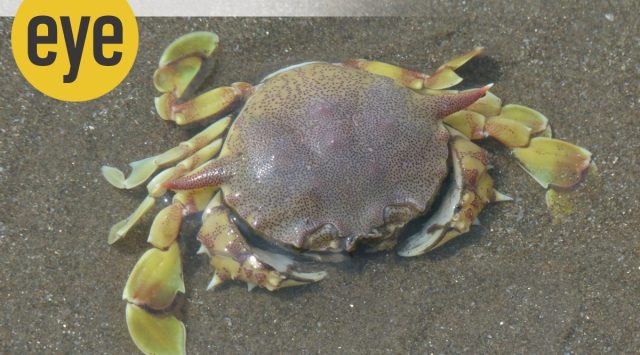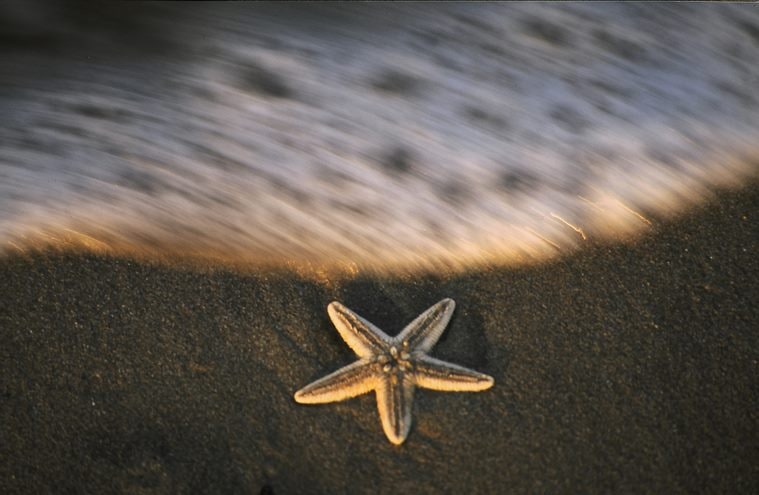When health doesn’t permit an escape to the mountains, beaches are your best friend
Many lucky people, with houses in lovely locales to which they can escape to now and then, still remain blind to nature’s bounty around
 The speckled swimming crab (Credit: Ranjit Lal)
The speckled swimming crab (Credit: Ranjit Lal)It’s funny how often your own “pearls of wisdom” can come back and bite you in the bum! I’ve hectored people long and loud about how they blunder about in the most beautiful natural landscapes and really see nothing at all (unless it’s tigers, lions, elephants and anything plus-size). Many lucky people have houses in lovely locales to which they escape as often as they can and still remain blind.
🚨 Limited Time Offer | Express Premium with ad-lite for just Rs 2/ day 👉🏽 Click here to subscribe 🚨
Well, having lived in landlocked Delhi for more than 40 years now, I would take off to the mountains as often as possible too — usually once a year. Actually, we’ve been traipsing off to the mountains ever since I could remember: when we lived in Madras back in the ’60s, it was Ooty and when we lived in Bombay (for 15 years), it was Mahabaleshwar, of course (poor Matheran got left out somehow). After being roasted in the plains, there was nothing quite like that first whiff of cool mountain air against your cheek — like that first gulp of chilled beer on a parched day. For a long while, it was just being “one with nature” (as all the pious pundits like to say) that was the main attraction.
Then I got interested in birds. Hill and forest birds are shy and quicksilver restless and can be difficult to winkle out. I was also interested in wildlife in general, so trips to sanctuaries and national parks were extra special, if few and far between. In Corbett, years ago, we were confronted (at a safe distance) by a “mad makhna”, who cocked his head and flapped his ears irritably as we fled back to the matchstick machan and awaited our pick-up elephants to arrive — which they did quite shortly. In Rajaji, we sent a huge bull elephant scurrying across the “rau” (or dried riverbed) when a colleague sneezed like a cannon firing in the huge echoing washroom. The elephant had just crossed over to the bank on our side just below the rest-house to have a snack. In Sariska, I caught a glimpse of just the tail end of a tiger in the grass as I nearly backed the car off the road in my excitement. There, too, we caught scent of big-cat close-up in one of the gullies — exactly the smell you get when you go near the tiger or leopard’s cage in the zoo. The lions in Gir, alas, were completely blasé about our presence, one pair even shamelessly honeymooning in front of us and our cameras. (The moral police were nowhere to be seen, but then lions have this “so what the hell are you going to do about it?” glint in their eyes, which is enough.) A furtive leopard, in the thickets, pointed out by a wildlife ranger made up for that somewhat though; and made you admire the animal’s superlative camouflage.
 Starfish on the beach (Credit: Ranjit Lal)
Starfish on the beach (Credit: Ranjit Lal)
Jim Corbett was a great hero with his stories about man-eating tigers (for whom he had the greatest empathy) and Gerald Durrell was great fun and a wonderful raconteur. And, of course, I would go on and on about how people only had eyes for the big glam guys: tigers, lions, elephants, rhino and suchlike and just weren’t interested in seeing anything else. Sadly, and ironically, as more people (and idiots) got interested in visiting these beautiful national parks and sanctuaries, strict regulations came into play. There are fixed hours, fixed routes, and if a tiger is spotted, it is mobbed by Gypsies crammed with jabberers who need to have their mouths duct-taped and mobiles confiscated. You can no longer just drive around at will and really be “one with nature”.
Which you still could be in the mountains — provided you were careful enough not to become “one with a landslide!” Due to health issues, I had a ceiling of 6,000 ft above sea level, which I was not supposed to ascend and, on one occasion, I did rather overdo things and had to return to sea-level hotfoot. I learnt to acclimatise myself properly and was fine thereafter. A series of recent heart-failure episodes has now damnably put paid to that and I doubt I will ever be able to visit the mountains again. As I was rushing post-haste and breathless for the hospital the last time this happened, I snatched up a book that had just come to me for review: Sejal Mehta’s Superpowers on the Shore. All I can say is that while having to ration my reading every day, I was kicking myself blue. Back in Madras, Elliot’s Beach had been a favourite getaway (after a cyclone, the sea would present us with glistening cowries, chunks of coral and sea fans, and once a seahorse, too), and in Bombay, we had spent innumerable weekends at Marve Beach wandering aimlessly on the sands and splashing through the tide pools without noticing a thing! This book made my eyes go wide; right there virtually underfoot was an astonishing, kaleidoscopic world crammed with the most amazing life and I had missed it all! Even Juhu Beach, which we had always derided for being too crowded and dirty, was crammed with fascinating life forms, not to mention the rocky causeway leading from Haji Ali to the island dargah.
Ah, but all is not lost. The mountains may be out of reach, but the beaches — you couldn’t get more sea-level than that! You just need to settle down near a rock-pool and keep your eyes open! And there’s 7,500 km of coastline at your disposal! As they say, when one door closes, a window opens.
- 01
- 02
- 03
- 04
- 05































